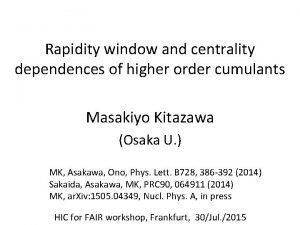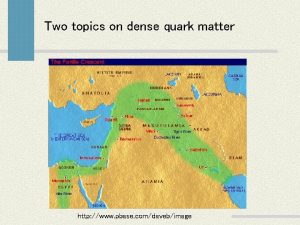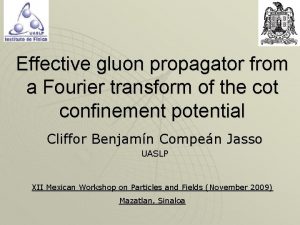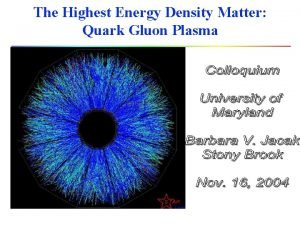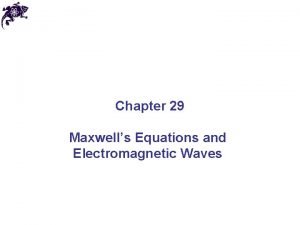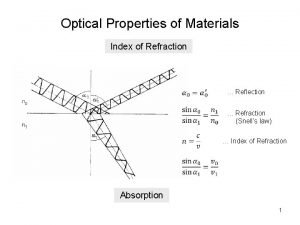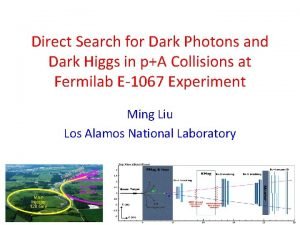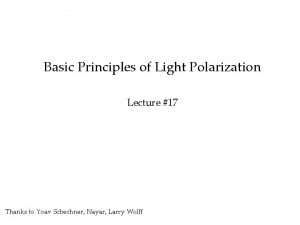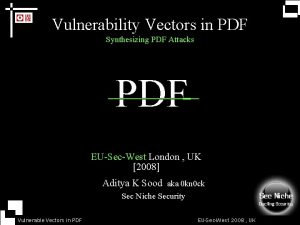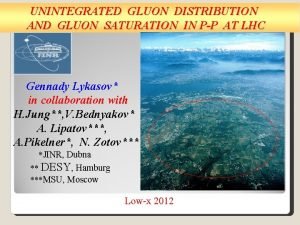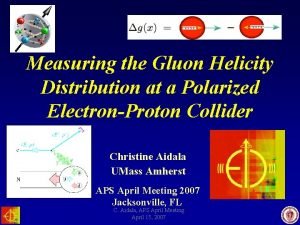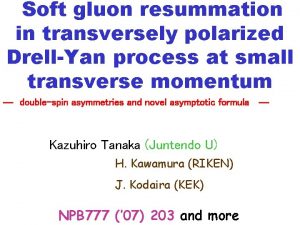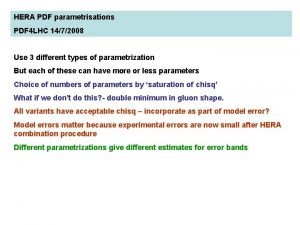Constraining the polarized gluon PDF in polarized pp





![PHENIX longitudinally polarized pp Runs Year s [Ge. V] Recorded L Pol [%] FOM PHENIX longitudinally polarized pp Runs Year s [Ge. V] Recorded L Pol [%] FOM](https://slidetodoc.com/presentation_image_h/1ffb51f543298cf44e258e24ba259e29/image-6.jpg)









- Slides: 15

Constraining the polarized gluon PDF in polarized pp collisions at RHIC Frank Ellinghaus University of Colorado (for the PHENIX and STAR Collaborations) July 2008 ICHEP’ 08, Philadelphia, USA Frank Ellinghaus, University of Colorado

Parton Distribution Functions (PDFs) PDFs fitted using F 2 at Q 2=4 U=u+c u, D=d+s d • From fits to F 2 measurements, unpolarized PDFs can be inferred – q=u, d (s, c) • The total fraction of nucleon momentum carried by quarks: – Gluons carry the other half! U=u+c u, D=d+s d Frank Ellinghaus, University of Colorado

Results from Inclusive Polarized DIS Polarized PDFs extracted from fits to g 1(proton, deuteron) • Analogous to unpolarized (F 2) case, g 1 can be used to fit polarized PDFs: • Result: Quarks carry only about 30 % of the nucleon spin ( 0. 3) • Gluon contribution G not well constrained due to small range in x. B, Q 2 (no polarized ep collider) …but polarized pp Collider !!! -> Frank Ellinghaus, University of Colorado

RHIC @ BNL p. C Polarimeters Polarimeter (H jet) STAR Spin Rotators Siberian Snakes Relativistic Heavy Ion Collider also provides longitudinally and transversely polarized proton beams at s = 200 Ge. V, 62. 4 Ge. V, (500 Ge. V, 2009+) Frank Ellinghaus, University of Colorado

PHENIX and STAR High rate capability Limited acceptance Large acceptance Azimuthal symmetry Frank Ellinghaus, University of Colorado
![PHENIX longitudinally polarized pp Runs Year s Ge V Recorded L Pol FOM PHENIX longitudinally polarized pp Runs Year s [Ge. V] Recorded L Pol [%] FOM](https://slidetodoc.com/presentation_image_h/1ffb51f543298cf44e258e24ba259e29/image-6.jpg)
PHENIX longitudinally polarized pp Runs Year s [Ge. V] Recorded L Pol [%] FOM (P 4 L) 2003 (Run-3) 200 . 35 pb-1 27 1. 5 nb-1 2004 (Run-4) 200 . 12 pb-1 40 3. 3 nb-1 2005 (Run-5) 200 3. 4 pb-1 49 200 nb-1 2006 (Run-6) 200 7. 5 pb-1 57 690 nb-1 2006 (Run-6) 62. 4 . 10 pb-1 48 5. 3 nb-1 (Similar numbers for STAR. Experiments can separately choose longitudinal or transverse polarization. ) Frank Ellinghaus, University of Colorado

DG via direct measurement Access to polarized gluon distribution function via double helicity asymmetry in inclusive polarized pp scattering, e. g. , Measure p. QCD, fragmentation fcts. from DIS Invariant mass spectrum of 2 photons in EMCal (M=135 Me. V) Relative Luminosity R using beam-beam counters Frank Ellinghaus, University of Colorado

First: Check unpolarized case! STAR -- jets PRL 97, 252001 (2006) PHENIX -- 0 PRD 76: 051106, 2007 Using a set of unpolarized PDFs ( + fragmentation functions in case of hadron ( 0) production) the cross section agrees with NLO p. QCD calculations. Frank Ellinghaus, University of Colorado

STAR -- jets Run 6 preliminary Run 5 (2005): PRL 100, 23 (2008) DG = G(x), -G(x) excluded; GRSV-std excluded with 99% CL Frank Ellinghaus, University of Colorado

PHENIX -- 0 at 200 Ge. V Run 6 preliminary Run 5: Phys. Rev. D 76: 051106, 2007 Run 6 preliminary GRSV: Glueck et al. , PRD 63 (2001) DG = G(x), -G(x) excluded; GRSV-std excluded on 3 sigma level: 2(std) 2 min> 9 Frank Ellinghaus, University of Colorado

STAR – 0 and PHENIX - h STAR 0 consistent with PHENIX h excludes DG = G(x), -G(x) so far Frank Ellinghaus, University of Colorado

+, –, 0 and the sign of DG Especially in the region where qg scattering is dominant (p. T > 5 Ge. V), the increasing contribution of d quarks (Dd<0) leads to: p- STAR -- Run 5 p+ Fraction of pion production “Model independent” conclusion possible once enough data is available. Frank Ellinghaus, University of Colorado

First pol. PDF extraction using pp data DSSV, ar. Xiv: 0804. 0422 First “global” (DIS+SIDIS+pp) analysis! DG small in measured range (0. 05 < x< 0. 2). Contribution at small or large x? • Measurement averages over certain x range • Shape of DG(x) cannot be extracted -> Value for first moment model dependent • Next step: Mapping of x-dependence via di-jets, di-hadrons and gamma-jet Different ranges in x can be probed in: • 500 Ge. V (2009+, lower x) and 62 Ge. V running (larger x, larger scale unc. ) -> • different rapidities -> Frank Ellinghaus, University of Colorado

Accessing different x-ranges PHENIX: 0 ALL at s=62. 4 Ge. V Increased sensitivity to larger x • • At fixed x. T = 2 p. T/sqrt(s) cross-section is 2 orders of magnitude higher at 62. 4 Ge. V than at 200 Ge. V Significant result at high x. T from small data set at 62. 4 Ge. V (0. 04 pb-1) when compared to 200 Ge. V data (1. 8 pb-1) STAR: 0 ALL at forward rapidity Increased sensitivity to smaller x • Also: step towards gamma-jet correlation measurements to map out the x-dependence Frank Ellinghaus, University of Colorado

Summary • Measurements of double helicity asymmetries in polarized pp scattering at PHENIX and STAR provided a significant constraint on the polarized gluon PDF in a global QCD fit to “all” DIS, SIDIS and pp data • DG(x) small in measured range 0. 05 < x < 0. 2 • Different beam energies (500 Ge. V, 2009+) and rapidities will give access to an order of magnitude smaller x • Correlation measurements will provide sensitivity to shape of DG(x) Frank Ellinghaus, University of Colorado
 Love constraining to obedience
Love constraining to obedience Quark gluon plasma
Quark gluon plasma Gluon force carrier
Gluon force carrier Quark gluon plasma
Quark gluon plasma Quark gluon
Quark gluon Gluon propagator
Gluon propagator Quark gluon
Quark gluon Gluon plugin
Gluon plugin Polarized pluralist model
Polarized pluralist model Homunculus
Homunculus A polarizer blocks 75% of a polarized light beam.
A polarizer blocks 75% of a polarized light beam. Non polarizable electrode
Non polarizable electrode Index of refraction formula with angles
Index of refraction formula with angles What is the light
What is the light Polarized physics
Polarized physics Polarized wave
Polarized wave



